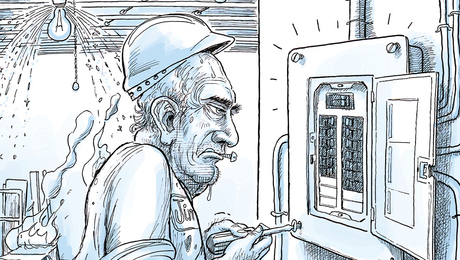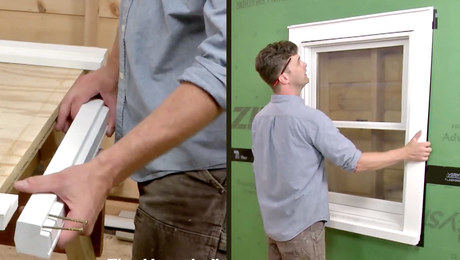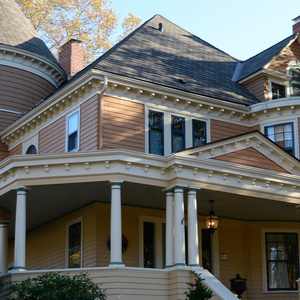I am a DYI homeowner currently engaged in a remodel of my 1960 house to provide a mother-in-law suite on the lower level of the home. Once this remodel is complete it will be difficult to make electrical or plumbing modifications because there will be no access to the underfloor space of the main level. The electrical work will be done by a contractor, but I have been doing a little reading on the subject. I have read that prior to 1965, house wiring was sheathed in rubber and that it has a 25 year service life. As I do the math, this means that, assuming the wire is sheathed in rubber, my entire electrical system is way out-of-date. Is this factual? If so, what should I be doing about it? Thanks.
Discussion Forum
Discussion Forum
Up Next
Video Shorts
Featured Story

Dangerous electrical work and widespread misconceptions cause fires, deaths, and $1.5 billion in property damage annually.
Featured Video
How to Install Exterior Window TrimHighlights
"I have learned so much thanks to the searchable articles on the FHB website. I can confidently say that I expect to be a life-long subscriber." - M.K.
Fine Homebuilding Magazine
- Home Group
- Antique Trader
- Arts & Crafts Homes
- Bank Note Reporter
- Cabin Life
- Cuisine at Home
- Fine Gardening
- Fine Woodworking
- Green Building Advisor
- Garden Gate
- Horticulture
- Keep Craft Alive
- Log Home Living
- Military Trader/Vehicles
- Numismatic News
- Numismaster
- Old Cars Weekly
- Old House Journal
- Period Homes
- Popular Woodworking
- Script
- ShopNotes
- Sports Collectors Digest
- Threads
- Timber Home Living
- Traditional Building
- Woodsmith
- World Coin News
- Writer's Digest


















Replies
I don't know ed, but here's a bump to get this seen again
Excellence is its own reward!
In and of itself rubber does not pose a problem. I have seen many installations where the 60 and even 70 year old wiring was, for the most part, in fine shape. The rubber was still tough, flexible and in near new condition. A lot depends on the particulars of the situation. Cables in attics, due mostly to heat, fare the worse. Sunlight, ozone, heat and general physical and electrical abuse take a toll.
Of course this doesn't mean much. Just because most of the wiring is in grand shape it only takes a few bad inches to lower the average reliability of the installation and possibly case a fire.
Another point is that you are presently remodeling, usually the best time to rewire, and it may be 60 years before as good an opportunity presents itself. So if you don't rewire now the wiring might have to last until it is 100 years old.
I have rewired houses during remodeling and not. In an extreme case, where the plaster or wallboard on interior walls is taken down completely, the rewiring is quick and easy, scarcely harder than wiring new construction. New boxes can be installed easily so adding receptacles, telephone and networking all goes smoothly. An electrician and a helper can fly. Removing the finish surface of at least one facing of each wall can do much the same thing in terms of making the wiring go quickly.
As less of the walls, and some ceilings if there is no crawlspace or attic, is removed for remodeling, or opened for wiring and patched, the rewire job becomes slower, more difficult and frustrating and very much more costly. A medium size house can be rough wired in about a day. The same house might take a week if the walls cannot be opened up. You may also pay a premium for a contractor experienced in this sort of old work. It is difficult and takes special people, knowledge, some specialized equipment and a considerable amount of patience and creativity.
That is the dynamic your up against. I don't know what your budget is, rewiring by professionals is not cheap even at its easiest. IMHO it is worth it. Not that doing this for a living in any way biases me.
I would rewire during the remodel. Bring everything up to code. Install all the extras above code that make life easy, it isn't much more if the walls are open. Extra receptacles in the kitchen, one or more dedicated computer circuits, extra receptacles in the office area. At least one phone connection in each room, I like one in the bathroom. Net and cable wiring will keep everything current. Have the electricians add empty conduits to any soon to any inaccessible areas, between floors and running between office areas and a central point for future communications updates. Go ahead and upgrade the panel and meter can.
All this is cheaper done all at once. Once done you can rest easy knowing that the entire house is good for another 60+ years.
You know, this is a question I have as well.
I've gutted an upstairs bedroom to the studs. New wiring includes a circut for 5 duplex plugs, track lights (2 bars) and a ceiling fan/light. Extra circut for in-window A/C just in case, and 2 extra circuts for the master bedroom on the other end of the house when we gut it next year. I need to re-insulate, and re-electrify since it's a 72 year old house with knob & tube.
There are parts of existing circuts up there: feeds from somewhere to the existing lights, to the half-bath next door and coming from I know not where. Just as bad, past the pony wall where I want to add insulation above my bedroom (downstairs), is K&T running from under the floor to the light switch & then to the light, and also down to the front entry and the switch legs there (to inside entry hall and outside entry stairs).
Because I want to add R40 of insulation, I had thought to have the electrician cut the K&T, install JBs and wire with 12-2 that 10' to the top plate. Then , when I open the walls downstairs, in a few years, I will have the feed, plus I can insulate now without worrying about heat buildup.
My electrician (cousin) asys the wires are in great shape, don't bother, and just leave it there.
I can easily isolate the ceiling boxes & put a heat shield around them & insulate.
What is your "second" opinion?Quality repairs for your home.
Aaron the HandymanVancouver, Canada
First a bit of history:Knob and tube wiring (hereafter abbreviated as K&T) was the first common and accepted wiring method. Forms of it date back to Edison. Some have noted that it was a variation of materials and techniques used by linemen. K&T wiring was an adaptation to deal with the limitations of the materials available at the time.
Most conductors were insulated with a combination of cotton or linen and vulcanized rubber. Modern plastics were unknown. It was well understood that the service life of these materials was limited. Particularly where it was exposed to heat, sunlight, ozone or any of a dozen common chemicals including petroleum products.
It was expected that the insulation around conductors would dry out, become brittle and fall off. The design of K&T wiring was such that insulation was not needed. Short were avoided by having the wiring suspended in air or only touching porcelain insulators. Picture power lines on poles. As long as they are suspended in air and nothing touches them everything is fine.
Of course most houses of the time had no insulation so K&T run in walls, crawlspaces and attics were still suspended in air. Everybody happy.
The problem:As I see it the real problem with K&T wiring is in its being covered, concealed or tampered with. Most thermal insulation used currently, with the exception of the foil radiant barriers, don't conduct electricity so no great danger of a short. It is possible that insulation could become damp due to moisture migration and allow a short but this would be a rare electrical problem.
A greater problem is concealment. If insulation was added over the K&T wiring it could create a snake-in-the-grass problem. A hidden and potentially deadly threat to anyone with their hand in the wall or crawling through the attic. Hot and sweaty you have one hand on a pipe. Any accidental contact with the insulated K&T could be fatal. Electricians are saintly souls and so we do not decompose or stink when dead. We emit a slight floral scent and a distant heavenly choir can often be heard near the body. All other trades on the other hand are more of a problem. A plumber decaying in the attic pretty much makes a house uninhabitable.
Modifications or system inadequacy are another cause for concern. In the days of K&T a single receptacle per room, a half dozen circuits per house, no ground wire and sometimes a 120v only service was considered acceptable. These systems, considered state of the art at the time, rapidly proved inadequate as more electrical appliances became available and people depended ever more on electrical power. I these early days, sometimes even today, systems were often upgraded by local handymen with little regard for codes or safety. I have seen some very creative interpretations of common sense, good wiring and the codes. K&T wiring seems more prone than more modern wiring methods as it is simpler in some ways.
What would I do:Don't allow any space with K&T wiring to be insulated. Most insulation contractors won't insulate a space until the K&T is replaced. Even barrier boards can fail to hold back loose insulation allowing it to drift and conceal the wiring. Batts can fall down or be shifted by people crawling through.
Try to arrange for workman's access for any voids that have K&T wiring. Chases. Short doors through knee walls, removable panels and hatches in closet ceilings go a long way toward keeping things easy to get at. This makes replacement at any later date much easier. This may also pay dividends for other trades and in general maintenance. It often can be used, with proper care and provisions, as storage.
As areas become accessible during renovation replace the K&T wiring. Consider replacing existing boxes. The smaller boxes that were rated sufficient many years ago often don't have enough volume to meet current codes. Install more circuits, break up existing circuits and add receptacles. It is difficult to install too many receptacles. Remember the code is the Minimum. Exceeding its requirements often makes sense.
Replacing the K&T will give you a working or more reliable ground system. Electronics are often dependant on the grounds as a voltage reference, starting aid and drain for surge currents. Surge arrestors do not do any good without a strong ground.
Often it is possible to do rewire in stages. go after the high amperage and high usage circuits first. Kitchen, bathroom (Especially if you use a blow drier), electric water heaters, any circuit used for a space heater and other similar circuits would be a good start but your particular use pattern will be the best guide.
A greater problem is concealment. If insulation was added over the K&T wiring it could create a snake-in-the-grass problem. A hidden and potentially deadly threat to anyone with their hand in the wall or crawling through the attic. Hot and sweaty you have one hand on a pipe. Any accidental contact with the insulated K&T could be fatal. Electricians are saintly souls and so we do not decompose or stink when dead. We emit a slight floral scent and a distant heavenly choir can often be heard near the body. All other trades on the other hand are more of a problem. A plumber decaying in the attic pretty much makes a house uninhabitable.
ROFLOL!
Most insulation contractors won't insulate a space until the K&T is replaced.
You must have smarter insulation guys in your area. The only folks in my area who object to K&T in thermal insulation are the firefighters and fire marshalls, and maybe 1 out of 10 electricians (teh rest say "Ah we've got thousands of houses here with it under insulation!")
_______________________
http://www.medic37.net/prayer.shtml
Your mileage may vary ....
Hallelujah
Tom
Surge arrestors do not do any good without a strong ground.
Could you explain what you mean by a "strong" ground? And how does one determine it?
_______________________
http://www.medic37.net/prayer.shtml
Your mileage may vary ....
Install arc-fault protection/breakers for the old wiring, when possible. As others have mentioned before, I have also seen the insulation break down near ceiling fixtures due to heat. Any movement that jars the wiring may cause the insulation to crumble (perhaps an unbalanced ceiling fan). The arc-fault protection (though expensive now) is just what is needed until new circuits are run to replace the old K&T circuits.
Electricians= saintly Souls..LMFAO Yup old Gunner is a prime example of one....
ToolDoc
Also, check with your insurance company. For one, State Farm has a different homeowners rate for 40 YO or less wiring vs. older installations.
In Southern California, there is a lot of knob and tube wiring. I suspect that you may not have K & T. Problems that come up with OLD wiring is what or how it was used or modified.
Don't let your mother-in-law use a microwave, coffee brewer, iron, air conditioner and especially a heater on the old wiring. There is no problem with televisions, computers, radios clocks or stereos.
Typical problems happen when a refrigerator, coffee maker and hair dryer is used at the same time which blows a fuse. Then some stupid guy gets them to change the 20 amp fuse to 30 amps.
I would recommend the old wiring remain and be maintained. Add a new separate circuit for just any high wattage item
the thing i noticed about original post is the question of covering access to an area. since you will no longer have access to this area it makes great sense to do something now to enable future repairs, additions and upgrades to the system.
another poster rightly stated that re-wiring by qualified professionals is expensive and worth it, but if it i was you, would spend some time figuring out what might possibly be needed in the future and then run conduit to facilitate access.
it may be that there are some electricians who dissaprove of help from homeowners, but if you do your homework, and properly run conduit wire can be pulled through, you may save yourself the headache of tearing holes for future access.
Another place to check for compromised wiring is in the boxes that feed ceiling lights. Using too high a wattage bulb for a given fixture can turn the wiring insulation in the box (and a few inches beyond) into a crumbling and potentially hazardous situation. I have done rewires in 3 of my homes (1950 and older). The first I did with an electrician and he helped me identify the problem areas. Knob and tube can be just fine if the insulation is still flexible. I pigtailed new Romex into all of my light fixtures as they all had brittle insulation.
bit
Has anyone thought of this wiring being in coduit?
If it is the job would be alot easier.
Ed-- one way to get around running all the wires you might need is to install a chase from your electrical panel area to an attic or other unfinished space. this way, you can always run any extra wires later. I usually use PVC pipe, about 1-1/2 or 2" for the chase. It gives plenty of room to pull wires. I would still do as much new wiring as possible while the walls are open.